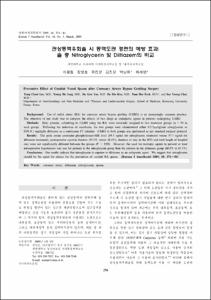KUMEL Repository
1. Journal Papers (연구논문)
1. School of Medicine (의과대학)
Dept. of Anesthesiology & Pain Medicine (마취통증의학)
관상동맥우회술 시 동맥도관 경련의 예방 효과 : 술 중 Nitroglycerin 및 Diltiazem의 비교
- Keimyung Author(s)
- Lee, Yong Cheol; Jang, Young Ho; Kim, Jin Mo; Park, Nam Hee; Choi, Sae Young
- Department
- Dept. of Anesthesiology & Pain Medicine (마취통증의학)
Dept. of Thoracic & Cardiovascular Surgery (흉부외과학)
- Journal Title
- Korean Journal of Anesthesiology
- Issued Date
- 2005
- Volume
- 48
- Issue
- 3
- Abstract
- Background: Use of radial artery (RA) for coronary artery bypass grafting (CABG) is an increasingly common practice.
The objective of our study was to compare the effects of two drugs as antispastic agents in patients undergoing CABG.
Methods: Sixty patients, submitting to CABG using the RA, were randomly assigned to two treatment groups (n = 30 in
each group). Following the induction of anesthesia, the two groups were administered either 0.2-2μg/kg/min nitroglycerin or
0.05-0.1 mg/kg/hr diltiazem as a continuous IV infusion. CABG in both groups was performed as per standard surgical protocol.
Results: The peak serum creatinine phosphokinase-MB level (59.3 ng/ml for nitroglycerin treatment versus 57.7 ng/ml for
diltiazem treatment), postoperative ejection fraction (52.3% versus 48.4%), duration of stay in the ICU and total length of hospital
stay were not significantly different between the groups (P > 0.05). However, the need for inotropic agents to prevent or treat
intraoperative hypotension was less for patients in the nitroglycerin group than for patients in the diltiazem group (60.0% to 83.3%).
Conclusions: Our results indicate that nitroglycerin is superior to diltiazem as an antispastic agent. We suggest that nitroglycerin
should be the agent for choice for the prevention of conduit RA spasm. (Korean J Anesthesiol 2005; 48: 274∼81)
- Alternative Title
- Preventive Effect of Conduit Vessel Spasm after Coronary Artery Bypass Grafting Surgery
- Publisher
- School of Medicine
- Citation
- 이용철 et al. (2005). 관상동맥우회술 시 동맥도관 경련의 예방 효과 : 술 중 Nitroglycerin 및 Diltiazem의 비교. Korean Journal of Anesthesiology, 48(3), 274–281.
- Type
- Article
- ISSN
- 2005-6419
- 파일 목록
-
-
Download
 oak-bbb-05542.pdf
기타 데이터 / 288.16 kB / Adobe PDF
oak-bbb-05542.pdf
기타 데이터 / 288.16 kB / Adobe PDF
-
Items in Repository are protected by copyright, with all rights reserved, unless otherwise indicated.